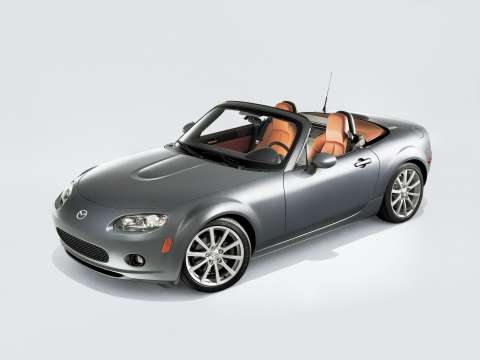
|

|

|
3rd March, 2005 Sixteen years after the original was unveiled, the wraps today come off the third generation Mazda MX-5 at the Geneva and Melbourne Motor Shows. New from the wheels up, the world’s favourite roadster remains true to the lightweight, fun to drive formula that has seen more than 700,000 MX-5s sold worldwide since 1989. To date more than 11,000 have been bought in Australia, a figure that is expected to grow significantly when the new car arrives about October. When creating the all-new Mazda MX-5, programme manager Takao Kijima and his team looked ahead to understand current motoring needs, while pinpointing and focussing on what makes this Mazda so special in the eyes and hands of car enthusiasts the world over. What the team found was an intensity of spirit possessed by very few sports cars. In Japanese, the exceptional soul of the Mazda MX-5 is described by the expression Jinba Ittai (pronounced gin-buy ee-tie). The direct translation is “rider and horse as one.” Updated for the 21st century, Jinba Ittai is akin to the bond between a single-seat formula-car pilot and his racer. Jinba Ittai is the essence of Zoom-Zoom. The rider-and-horse idiom and the effort to create a car universally seen as “lots of fun” served as the focal point around which the original and the all-new Mazda MX-5 were designed and engineered. Five basic requirements were defined by Mazda engineers to realise the Jinba Ittai concept.
There’s a natural tendency for curb weight to increase when meeting growing market demands. Realising that this is contrary to the Jinba Ittai goal and that extra weight would have a dramatically negative influence on driving, cornering, and braking performance, Mazda engineers made every gram count. (In the English measurement system used in the U.S. and elsewhere, one pound equals 454 grams.) Their “gram strategy” assessed weight in the smallest possible increments and carefully scrutinised weight-trimming opportunities. Other weight-saving tactics were employed as well. Advanced technology was applied where practical to achieve a light and rigid unibody design using materials that offered higher strength and lighter weight. In its final form, the new Mazda MX-5 is more powerful, more capable, more comfortable, and more useful. It offers several new features and further improves occupant protection from collision injury. Yet, curb weight has only increased by approximately 10kg. The process of evolution of this icon car is evident in the bold new look of the MX-5. On the outside the most notable departure from the previous exterior shape is the elimination of the classic “Coke bottle” shape of the contours. The nose and tail are smoothly tapered, as before, but now the surfaces wrap smoothly between the wheels without narrowing. The fender arches of the new Mazda MX-5 are notably more pronounced to accommodate the substantially wider wheel track dimensions and to provide a more athletic stance. Seventeen-inch wheels help define the corners of the car and are consistent with Mazda’s design DNA. The wide shoulder area of the body tapers to a narrower sill to lend a light-on-its-feet look. In profile, the Mazda MX-5 continues the low, flowing shoulder line established by the original with side surfaces just below the shoulder creating prominent highlights between the wheels for a strong and muscular look. To accentuate the tapering shapes at each end of the Mazda MX-5, headlights and taillights are positioned well inboard of the car’s corners. So, in spite of modest increases in wheelbase (+65 mm), length (+20 mm), width (+40 mm), and height (+20 mm), a tight, compact look is maintained. Inside, the cabin offers more hip, shoulder and elbow room, a tilt adjustable steering wheel and plenty of storage compartments. Convertible buyers will appreciate the high-quality folding soft top, which features a Z-fold design with one centrally located latch handle. In the lowered position, it fits flush and smooth. The top can be raised or lowered without undue effort or stretching. Employing Mazda’s new generation sport car architecture the car boasts 22 per cent more flexural stiffness and a 47 per cent increase in torsional rigidity compared with the previous-generation Mazda MX-5. And moving the engine rearward by 135 mm was a major step towards balancing front-to-rear weight distribution and reducing the yaw moment of inertia. The new car also benefits from ideal 50:50 weight distribution. Australian MX-5s will be powered by a free-revving 2.0-litre MZR engine with 118kW (ECE), a jump of more than 10 per cent over the superseded model and 188Nm of torque (up 11.9 per cent) and delivered to the rear wheels by a six-speed manual or six-speed automatic transmission. Suspension is by double wishbones at the front and multi-links at the rear. Safety features will include ABS anti-lock brakes and dual front and front side airbags that offer both chest and head protection. Pricing and final specification will be confirmed at the car’s Australian launch. Mazda MX-5 - Major Specifications
|

Click the logo for our home page |